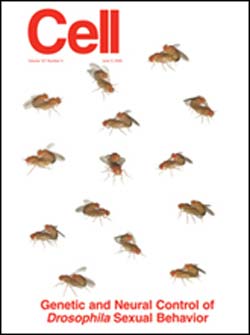Single gene is genetic switch for fly sexual behavior

A male fly’s sexual courtship of a female fly is a complicated business of tapping, singing, wing vibration, and licking, but a single gene is all that is needed to produce this complex behavior, according to new research published in this week’s issue of the journal Cell.
The gene encodes the Fruitless protein. Male and female flies carry different versions of the fruitless protein, as a result of sex-specific splicing of the mRNA. The male form of Fruitless is critical for the male courtship ritual and males’ preference for mating with females, as previous studies have shown.
Now, Barry J. Dickson and Ebru Demir of the Institute of Molecular Biotechnology of the Austrian Academy of Sciences show just how intimately fruitless is linked to these stereotypically male behaviors. They discovered that female flies with the male version of fruitless behave like males, directing at other females a sexual display nearly identical to their male counterparts.
Female flies with the male version of the protein also make amorous advances toward male flies that express female pheromones. In these cases, “we have been able to reverse the sex roles during Drosophila courtship,” Dickson and Demir say.
Dickson and Demir created male-spliced versions of fruitless in female flies and female-spliced versions in male flies. Males with the female version of fruitless “barely court at all” when paired with virgin female flies in an observation chamber, according to the researchers.
Males with the female fruitless splice form were also more likely to court other males than flies with the male form, suggesting that male-specific fruitless splicing “not only promotes male-female courtship, it also inhibits male-male courtship,” the researchers say.
Dickson and Demir refer to fruitless as a behavioral “switch gene” that is both necessary and sufficient to produce a particular behavior. Switch genes that trigger the development of a particular anatomical feature like wing structure have been studied extensively, but there are very few studies of switch genes that control a complex behavior, the researchers note.
In part, this is because finding behavioral switch genes can be a difficult task. The key, says Dickson, is demonstrating that a specific gene is sufficient to produce a particular behavior.
“This means showing that gene X is sufficient to create the potential for behavior Y in an otherwise normal animal. It is the ’otherwise normal’ part that is tricky,” he says.
“Putting gene X into another species and expecting to see a behavior is unrealistic–a ’flight’ gene from Drosophila, if it existed, is not going to make a mouse fly,” Dickson explains, noting that only members of the same species might be expected to share the same set of “normal” behaviors.
“So you need to put gene X in a normal animal of the same species that doesn’t normally do Y. This is really only possible with sex-specific behaviors” like courtship, he says.
Dickson also says there is “something of a debate going on between the view that single genes can have profound effects on behavior, versus the more holistic view that behavior is so complex that we can never learn anything meaningful about a behavior by studying the action of a single gene.”
Still, studies show that a single gene can trigger the development of complex anatomical structures like eyes or limbs, by influencing sometimes hundreds of other genes, Dickson notes.
“I don’t see any good reason why innate behaviors, which are a consequence of how the nervous system is built, should be any different. Indeed, I think that is what our work shows,” he says.
In a second Cell paper, Dickson and colleagues demonstrate that nerve cells expressing the fruitless gene are linked in a circuit in both males and females. The finding suggests that the “essential difference in sexual behavior between males and females lies in the functioning of this circuit and not its construction,” according to the researchers.
Dickson and colleagues have already begun collaborations with other researchers to determine how the fruitless gene might be involved in other behavioral patterns like aggression. “I think it is going to be fascinating to try to figure out how a fly decides between ’love’ and ’war’, and what fruitless and the fruitless-expressing neurons have do to with this,” he says.
Media Contact
More Information:
http://www.cell.comAll latest news from the category: Life Sciences and Chemistry
Articles and reports from the Life Sciences and chemistry area deal with applied and basic research into modern biology, chemistry and human medicine.
Valuable information can be found on a range of life sciences fields including bacteriology, biochemistry, bionics, bioinformatics, biophysics, biotechnology, genetics, geobotany, human biology, marine biology, microbiology, molecular biology, cellular biology, zoology, bioinorganic chemistry, microchemistry and environmental chemistry.
Newest articles

Properties of new materials for microchips
… can now be measured well. Reseachers of Delft University of Technology demonstrated measuring performance properties of ultrathin silicon membranes. Making ever smaller and more powerful chips requires new ultrathin…

Floating solar’s potential
… to support sustainable development by addressing climate, water, and energy goals holistically. A new study published this week in Nature Energy raises the potential for floating solar photovoltaics (FPV)…

Skyrmions move at record speeds
… a step towards the computing of the future. An international research team led by scientists from the CNRS1 has discovered that the magnetic nanobubbles2 known as skyrmions can be…





















